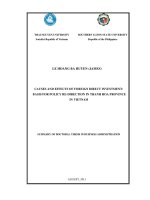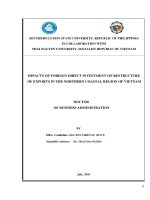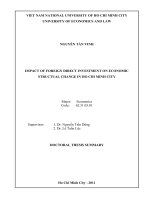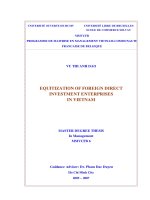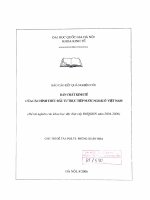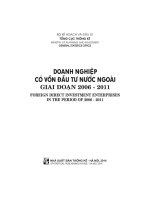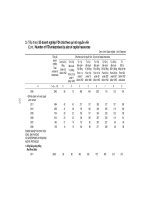Equitization of foreign direct investment enterprises in Vietnam
Bạn đang xem bản rút gọn của tài liệu. Xem và tải ngay bản đầy đủ của tài liệu tại đây (517.37 KB, 105 trang )
UNIVERSITEÙ OUVERTE DE HCMV UNIVERSITEÙ LIBRE DE BRUXELLES
ECOLE DE COMMERCE SOLVAY
MMVCFB
PROGRAMME DE MAITRISE EN MANAGEMENT VIETNAM-COMMUNAUT
E
FRANCAISE DE BELGIQUE
VU THI ANH DAO
EQUITIZATION OF FOREIGN DIRECT
INVESTMENT ENTERPRISES
IN VIETNAM
MASTER DEGREE THESIS
In Management
MMVCFB 6
Guidance Adviser: Dr. Pham Dac Duyen
Ho Chi Minh City
2005 – 2007
- ii -
LETTER OF ASSURANCE
I’m hereby testify that this is a self-studied topic which
written by Vu Thi Anh Dao
All the figures, data lead to outcome indicated in this
thesis are quite truly
Vu Thi Anh Dao
T
T
h
h
e
e
M
M
a
a
s
s
t
t
e
e
r
r
i
i
n
n
M
M
a
a
n
n
a
a
g
g
e
e
m
m
e
e
n
n
t
t
P
P
r
r
o
o
g
g
r
r
a
a
m
m
(
(
M
M
M
M
V
V
C
C
F
F
B
B
6
6
)
)
2
2
0
0
0
0
5
5
-
-
2
2
0
0
0
0
7
7
- iii -
ACKNOWLEDGEMENT
Two years for this course was not considered such as long period of time but at
least something, the course cover quite broad, therefore a self-taught without
experience exchange and valuable guidance from the Professors will not drive
me to the today success.
I would like to express my highly appreciation to all the Professor who
conducted in this matter in management program for their hard works, valuable
guidance on the lecture throughout the course.
Many thanks the Professors “Pham Dac Duyen” for his enthusiasm who gave
good counsel and advises on my understanding to complete this thesis.
Next, I wish to thank you the Board of Director, Head of Investment Promotion
Dept. and all the colleagues of Southern Foreign Investment Center – Ministry
of Planning and Investment. Who have provide useful supports in gathering of
information and discussion to prepare this final report.
I also thanks Ms. Bui Phan Bao Tran and Mr. Serge Bywalski for taking the time
and providing constructive assistance, tutorship on the study and this thesis
preparation.
The last but not least, I would like to send my gratitude to all my classmate.
Especially, all Group 1 members who have accompany with me to all a long trip
today.
V
V
u
u
T
T
h
h
i
i
A
A
n
n
h
h
D
D
a
a
o
o
T
T
h
h
e
e
M
M
a
a
s
s
t
t
e
e
r
r
i
i
n
n
M
M
a
a
n
n
a
a
g
g
e
e
m
m
e
e
n
n
t
t
(
(
M
M
M
M
V
V
F
F
F
F
B
B
6
6
)
)
2
2
0
0
0
0
5
5
-
-
2
2
0
0
0
0
7
7
- vi -
TABLE OF CONTENTS
Page
PREFACE xii
• The imperative of the thesis xii
• The thesis purposes xiii
•
Objects and scope of studying xiv
• The research methodology xiv
• The thesis contents xv
CHAPTER 1 1
OVERVIEW ON FDI & EQUITIZATION OF FDI ENTERPRISE 1
1.1 Overview on FDI 1
1.1.1 Basic conception 1
1.1.2 The role of FDI in developing countries 2
1.1.3 Characteristics of FDI in Vietnam 5
1.2 Equitization of FDI Enterprises 9
1.2.1 Characteristic of join-stock company 9
1.2.1.1 History of shareholding company 9
1.2.1.2 The concept about shareholding companies 10
1.2.1.3 Basic characteristics of shareholding company 10
1.2.1.3.1 The aspect of ownership 11
1.2.1.3.2 The aspect of finance 11
1.2.1.3.3 The aspect of management organization 14
1.2.2 Equitization of FDI enterprises 16
1.2.2.1 The concepts of equitization and privatization of SOEs 16
1.2.2.2 The implementation process of SOE’s equitization in Vietnam 18
1.2.2.3 Experiences in equitization in some countries 21
- vii -
1.2.2.3.1 Privatization process in England 21
1.2.2.3.2 The privatization implementation in the Federal Republic of Russia. 22
1.2.2.3.3 Equitization of SOEs in China 23
1.2.2.4 Particulars of FDI enterprises’ equitization 24
1.2.2.5 Experience in the implementation of FDI enterprises’ equitization in
China 25
CHAPTER 2 28
THE PERFORMANCE OF THE EQUITIZATION 28
OF FDI ENTERPRISES IN VIET NAM 28
2.1 The policies and legal bases for FDI Enterprises equitization 28
2.1.1 Vietnam basic policies and the conversion from FDI Enterprises to
FIS Companies 28
2.1.1.1 The policy of equitization 28
2.1.1.2 Contents of equitization 29
2.1.1.2.1 Conditions 29
2.1.1.2.2 Forms of conversion 31
2.1.1.2.3 Determination of the Enterprise’s Value 32
2.1.1.2.4 Operation of FIS companies 34
2.1.1.2.5 Procedures and formalities of the implementation of conversion 36
2.1.2 Legal grounds for and State management of the FIS company 38
2.1.2.1 Legal grounds for the FIS companies: 38
2.1.2.2 State management of FIS companies. 40
2.2 Present situation of equitization of FDI enterprises 41
2.2.1 General situation 41
2.2.2 The situation through the study of 9 equatized FDI enterprises 41
2.2.2.1 The conversion model of Austnam Shareholding Company 43
2.2.2.2 The conversion model of Royal International Shareholding Company 44
- viii -
2.2.2.3 Conversion model of Vietcans Shareholding Company 45
2.2.2.4 Conversion model of Full Power Shareholding Company 46
2.2.2.5 Conversion model of Tung Kuang Industrial Shareholding Company 47
2.2.2.6 Conversion model of Taya (Vietnam) Electric Wire and Cable
Shareholding Company 48
2.2.2.7 Conversion model of Chang Yih Ceramic Shareholding Company. 49
2.2.2.8 Conversion model of International Food Shareholding Company 50
2.2.2.9 Conversion model of the Taicera Industrial shareholding Company Ltd.
51
2.2.3 The results, the limitations and the causes 52
2.2.3.1 The results: 52
2.2.3.2 Limitations and causes 55
CHAPTER 3 58
SOME MEASURES TO IMPROVE 58
THE EQUITIZATION OF FDI ENTERPRISES 58
3.1 The macroscopic measures 58
3.1.1 Viewpoints on the management policy of FDI enterprises 58
3.1.2 Perfecting the legal system concerning the conversion of FDI
enterprises 61
3.1.3 To improve the stock market for pushing up equitization 62
3.1.4 To attract the international investment funds for accelerating the
equitization process 67
3.1.5 To improve other barriers 68
3.1.5.1 The responsibilities of State management authorities 68
3.1.5.2 The policies on the workers and the converted enterprises 69
3.1.5.3 The dissemination of equitization knowledge 70
3.2 Concrete solutions 72
- ix -
3.2.1 Solutions to the FIS companies 72
3.2.2 Solutions to other FDI enterprises. 73
3.2.3 To flexibly apply the different methods to determine the enterprises’
value in the conversion 74
3.2.4 Solutions with regard to the share issuance of FDI enterprises when
converted to shareholding companies 76
3.2.5 The State should early decide on the opening of “room” for FDI
enterprises while the Law on Securities is already effective. 77
3.2.6 To consolidate the foreign currency control over the FDI enterprises
in conversion to shareholding companies 78
3.2.7 The organization of implementation 79
CONCLUSION 81
- x -
LIST OF ABBREVIATIONS
•
BCC : Business Co-operation Contract
•
BOT : Build-Operate-Transfer
•
BT : Build-Transfer
•
BTO : Build-Transfer-Operate
•
EPZ : Export Processing Zone
•
FDI : Foreign Direct Investment
•
FIA : Foreign Investment Agency
•
FII : Foreign Indirect Investment
•
FIS : Foreign Invested Shareholding
•
GMS : General Meeting of Shareholders
•
IZ : Industrial Zone
•
MOF : Ministry of Finance
•
MPI : Ministry of Planning & Investment
•
ODA : Official Development Assistance
•
SGCs : State General Corporations
•
SMEs : Small and Medium Enterprises
•
SOEs : State-owned Enterprises
•
SSC : State Securities Commission
•
TNCs : Transnational Corporations
- xi -
LIST OF GRAPHS AND TABLES
Page
Table 1.1: Total investment capital by economic sector 6
Table 1.2: GDP structure by economic sectors 6
Graph 1.1: FDI statistics from 1988 to Dec.2006 7
Graph 1.2: FDI statistics by sector from 1988 to Dec.2006 8
Graph 1.3: Top Foreign Investors from 1988 to Dec.2006 8
Table 2.1: the FIS enterprises listed on the stock market 42
Table 2.2: Business situation of FIS companies in 2005 53
Graph 3.1: Vietnam Stock Market in the period 2000 – 2006. 64
Table 3.2: Structure of transactions at Hochiminh City stock exchange in 2006.65
- xii -
PREFACE
• The imperative of the thesis
In the initial stage of economic development, Vietnam has encountered a
difficult matter: lack of capital due to low internal accumulation, thus restricting
investment scale and equipment renewal. After 18 years of attracting foreign
investment capital, in 2005, foreign direct investment (FDI) capital covers 15.7%
of total social investment capital, 55% of export turnover, 16% of GDP, and over
US$ 1 bil. for national budget. FDI capital also uses redundant labor force,
creates jobs for over 1 million people, trains management teams, and forms the
behaviors of industrial production. In addition, FDI capital accelerates the
process of industrialization and enhances Vietnam’s position in the world.
With such results, the preservation and encouragement of FDI capital is a
imperative matter in the economic development policy, especially when there is
a strong competition in the attraction of FDI capital.
According to the previous provisions of Law on Foreign Investment,
foreign investors operate in Vietnam chiefly in the forms of business cooperation
contract, joint-venture and 100% foreign-owned. All these forms are of limited
liability company, thus restricting the capacity of mobilizing capital for
production development…
Shareholding company is so popular in the world. It is also provided in the
Law on Enterprises (old) and applied for the local companies. In April, 2003, the
government promulgated the Decree 38/2003/ND-CP on the conversion of some
enterprises to shareholding companies, by which, the form of shareholding
- xiii -
companies is applied on the pilot basis to some enterprises with the Prime
Minister’s permission.
At the end of 2005, Law on Enterprises and Law on Investment are
promulgated and come into effect from 1/7/2006, entitling the foreign investors
to select the forms of investment, including the shareholding company.
The form of shareholding company is rather new in Vietnam. Many
complicated matters on legality and finance are raised: how is it applied? How to
solve the problems of capital, investment priorities, enterprises’ value
determination, …? How to implement the conversion of the foreign invested
shareholding companies to shareholding companies by the Decree 101/2006/ND-
CP dated 21/9/2006 on the re-registration and enterprises’ conversion? What
entanglements in reality?
From the above matters, I decide to choose the topic: “EQUITIZATION
OF FOREIGN DIRECT INVESTMENT ENTERPRISES IN VIETNAM” as my
thesis.
• The thesis purposes
Equitization is rather new, and we are still lacking knowledge and
experience in policy planning as well as in organizing the implementation,
especially the legal procedures, enterprises’ value determination, ownership
transfer, In reality, dependent on the history, the development level of a
country, and the enterprises’ scale, the process of ownership transfer has its
specific characters. Therefore, there is no common formula on the equitization or
privatization for all countries.
Arising from such observations, the thesis, on the basis of privatization
experiences in some countries in the world, tries to study the pilot equitization of
- xiv -
FDI enterprises and our economic characters. Combining the theories on
shareholding companies, the thesis presents the core measures to effectively
implement the form of shareholding companies to the FDI enterprises in
Vietnam at the time being as well as in the future.
• Objects and scope of studying
The objects for studying are the FDI enterprises and the scope is the
matters concerning the conversion of a FDI enterprises into shareholding
companies and the formation of a new foreign company in the form of
shareholding company in Vietnam.
The thesis studies, first, the theories on FDI enterprises beside the forms
of shareholding companies such as: the concepts on FDI enterprises, operation
system and financial mechanism,…
The problems regarding the conversion of some FDI enterprises to
shareholding companies by the provisions – old and new- are also studied. The
thesis analyzes the entanglements and suggests the appropriate solutions In
addition, the thesis focuses on the real situation of FDI enterprises in Vietnam
and objectives set up for the application of shareholding company form to find
out the basic matters for presenting the solutions.
• The research methodology
In accordance with the topic, the approach is from the realities, in
comparison with the theory. The analysis is always based on the reality, and
applies arguments, theories for suitable solutions.
- xv -
The methodology of dialectic materialism is applied throughout the thesis.
Many other scientific methodologies are also used such as: analysis, comparison,
synthesis, logic & history, mathematics and statistics …
• The thesis contents
The thesis is composed of 3 chapters and the conclusion as follows:
Chapter 1: Overview of FDI and equitization of FDI enterprises.
Chapter 2: The performance of the equitization of FDI enterprises in Vietnam
Chapter 3: Some measures to improve the equitization of FDI enterprises in
Vietnam
The Conclusion
CHAPTER 1
OVERVIEW ON FDI & EQUITIZATION OF FDI ENTERPRISE
1.1 Overview on FDI
1.1.1 Basic conception
Foreign Investment or International Investment is the investment
activities beyond a nation and of two forms: foreign direct investment and
foreign indirect investment.
• Foreign Indirect Investment (FII or FPI: Foreign Portfolio Investment):
is a form of investment in which the capital investing people – foreign investors
– and the capital using people are different entities. That means the investors do
not participate directly in the management of the investment activity.
This investment form is carried out by way of the purchase of shares,
share certificates, bonds, other valuable papers or through securities investment
funds and intermediary financial institutions.
• Foreign Direct Investment (FDI): means a form of investment whereby
the foreign investor invests his capital and participates in the management of the
investment activity.
This investment form is carried out by way of the establishment of
economic organization 100% Foreign-Owned; Joint Venture; contractual forms
of Business Co-operation Contract (BCC), Build-Operate-Transfer (BOT), Build-
Transfer-Operate (BTO) and Build-Transfer (BT); to invest in business
development; to purchase shares or to contribute capital in order to participate in
the management of investment activities; to invest in the carrying out of a
merger and acquisition of an enterprise; to carry out other forms of direct
investment.
- 2 -
1.1.2 The role of FDI in developing countries
FDI is a new activity in Vietnam, but in the world, it has appeared over 70
years together with the business activities of companies and economic groups.
The big companies get a role to authorize the business at many countries, being
known with difference name: Multi National Corporation (MNC), Transnational
Corporation (TNC) and Global Company.
Although with different name, but reality companies mentioned above
have the same characteristic of business implementation on the market of two
countries and more.
With respect to the countries receiving foreign investment, slow or
developing countries, FDI plays the importance role in pushing up economic
development and increasing national income. FDI shall help the Government in
those countries reach the greater economic development objectives. The benefits
brought by FDI bring to developing countries are included:
Ü Raising source of social investment
In the developing countries due to lack of state budget, international debt
not yet payable, low internal accumulation.…, often do not have enough capital
investment. In such a condition, the source of FDI capital shall contribute to
solve the problem effectively, because compared with ODA and international
investment credit, FDI capital is more safer. It neither influence over the capital
managed by the Government nor raise Government debts and nor influence
directly on the international balance of payments.
Ü Job creation
- 3 -
The FDI projects, when implemented, will ensure jobs and stable income
for local workers. In fact, for the developing countries, FDI is put in with the main
purposes of looking for resources and labor at low price or of suitable professional.
Ü Receiving technology transfer
In the investment receiving countries, the worker in FDI enterprises can
master the technology transferred and after that they can participate in the local
enterprises. Though in any form or at any level, the technology transfer has the
tendency to increase labor output for those countries.
Ü Encouraging local investment
Experience in many countries has shown that FDI will not encroach upon
the local investment. On the contrary, it will encourage. Local enterprises have
opportunities to become the suppliers or distributors of FDI enterprises. In
addition, FDI enterprises create the competition in a few economic sectors that
are previously under the monopoly one or some local enterprises.
Ü Contributing to increase of state budget
The FDI enterprises will create the significant source for state budget of
investment receiving countries. Although the Government applies tax holiday
policy for foreign investors in a certain of time, it still has other revenue out of
tax and revenue from foreign currency through export of FDI enterprises.
Ü Pushing up economic development in the undergrown regions
Some countries encourage foreign investor to invest in the areas which are
still in difficult socio-economic conditions. To some extent, FDI has contributed
to push up the economic development in the backward regions
Ü Contributing to establish the Industrial Zones and Export Processing
Zones
- 4 -
With respect to developing countries, FDI plays the importance role to
establish and promote efficiency of Industrial Zones and Export Processing
Zones.
FDI develops at high speed and becomes an economic relation form that
has an important role for the development of country and international economy.
Most developed industrial countries as well as the developing ones have opened
the door to attract FDI.
The research of United Nations Conference on Trade and Development
(UNCTAD) on FDI’s prospect over the world in period 2005-2008 has shown
that FDI source tends to move from developed countries to some newly
emerging countries, especially the countries in Asia-Pacific regions. In 2004,
FDI capital flow in this regions achieved US$ 148 bil., increased US$ 46 bil.
compared with 2003. The high speed of economic development together with
improving policy environment and strategic commitments strategies of
Transnational Corporations (TNC) in regions are the factors that push FDI capital to
flow to this region in the coming year.
China is typical of successful FDI mobilization among Asian countries.
Over two recent decades, China was successful in attracting FDI. FDI source of
capital in this country increases from US$ 3 bil. in1990 to US$ 40 bil. in 2000 and
US$ 53 bil. in 2005. FDI attends many China’s industries and contributes to the
change of industrial structure. Industrial production value of FDI sector has
grown from 7% in 1990 to 28% in 2000. FDI’s enterprises have the highest
productivity (twice compared with SOEs).
FDI contributes an important part in the whole investment capital of
China, holding circa 3% GDP. It also contributes in the ratio of value added tax
in China.
- 5 -
In 1995, FDI’s enterprises in China accounted for 61% of garment and
shoes export, creating many jobs, accounted for 3% urban employment and
played the important role in privatization process. The role of FDI is not strong if
we consider the financial contribution to the balance of payment, but it helps the
balance of payment of China stronger in recent years and foreign currency
provision (increased more ca. US$ 50 bil, in 2001) higher.
Among Asian countries, China and India are considered as the most
attractive places for investment. The following are Thailand, South Korea,
Malaysia, Indonesia, Vietnam and Singapore.
1.1.3 Characteristics of FDI in Vietnam
The main purpose of FDI’s mobilization in Vietnam is to perform the task
economic industrialization, in which, mainly to strengthen investment capital, to
attract foreign currency; to use the source of labour, raw materials, natural
resources in Vietnam; to transfer modern technology; to expand export market;
to manufacture imported goods and goods for replacing the imported ones, and to
build infrastructure …
In the initial phase of economic development, Vietnam has encountered a
financial problem: lack of capital, due low internal accumulation, this restricting
investment scale and equipment renewal. After 18 years of attracting FDI, since
the promulgation of Foreign Investment Law, this capital has contributed
significantly to the increase of investment capital for the economy of Vietnam. In
2006, FDI’s capital accounted for 16.3% of total investment capital in society.
- 6 -
Table 1.1: Total investment capital by economic sector
State-owned Local private Foreign Investment
Year 2000 59,1% 22,9% 18%
Year 2005 52,2% 32,1% 15,7%
Year 2006 50,1% 33,6% 16,3%
Source: General Statistical Office
Table 1.2: GDP structure by economic sectors
Year 1995 2000 2005
GDP of country (%)
In which:
State-owned (%)
Local private (%)
Foreign Investment
100
40,2
54,8
5,0
100
38,5
48,2
13,3
100
38,4
45,7
15,9
Source: General Statistical Office
According to Foreign Investment Agency – Ministry of Planning and
Investment (MPI), at the end of December 2006, Vietnam has 6,813 FDI projects
(in validity) with total registered investment capital of US$ 60.47 bil.,
implemented capital of operational projects reached US$ 28.78 bil., in which, the
FDI has mainly gone to industrial production and construction sectors. The
countries and territories leads in investment in Vietnam are: Taiwan, Singapore,
Japan, South Korea, Hong Kong…
In year 2006, export value of FDI sector excluding crude oil reached US$
14.5 bil., increasing 30.1% compared with previous year; and if including crude
oil is US$ 22.6 bil., amounting to 57% of the country’s total export value. Import
of FDI sector has reached US$ 16.35 bil., increasing 19.3% compared with year
2005.
- 7 -
FDI capital contributes 37% of the country’s total industrial production
value, 55% export turnover, 16% of GDP (statistics in year 2005) and more than
US$ 1 bil. to State budget.
The number of people working in the FDI sector increased from 220,000
in 1996 to over 1,000,000 currently, with many well-trained workers and
managers. Besides, FDI also helps to quickly push the industrialization process
and contributes to enhance the position of Vietnam in the world.
Graph 1.1: FDI statistics from 1988 to Dec.2006
37
68
108
151
197
269
343
37
0.37
0.58
0.84
1.32
2.17
2.9
3.77
6.53
8.5
3.9 3.9
1.57
1.62
1.9
2.84
5.8
7.83
2.5
2.01
0
325
345
275
311
371
502
802
752
679
922
833
0
100
200
300
400
500
600
700
800
900
1000
1988
1989
1990
1991
1992
19
93
1994
1
995
1996
1997
1998
1999
20
00
2001
20
02
2003
2004
2005
De
c-06
No. of Projects
0
1
2
3
4
5
6
7
8
9
Total Inv Capital (US$ bil
)
No. of projects
Total Inv Capital US$bil
Foreign direct investment
from 1988 – Dec/2006
Source: FIA – Ministry of Planning & Investment
- 8 -
Graph 1.2: FDI statistics by sector from 1988 to Dec.2006
67.5%
20.3%
12.2%
Industry & Construction
Service
Agri-Aqua-Forestry
62.9%
30.7%
6.4%
FDI by sector from 1998 to Dec.2006
No. of projects (%) Investment capital (%)
Source: FIA – Ministry of Planning & Investment
Graph 1.3: Top Foreign Investors from 1988 to Dec.2006
Top of Foreign Investors in Vietnam
No. of project from
1988 – Dec/2006
Total capital from
1988 – 12/2006 (US$ bil.)
1.07
1.33
1.36
1.63
1.65
2.11
2.19
2.36
3.22
5.27
7.39
7.79
8.07
8.11
B.V. Islands
Singapore
Japan
South Korea
Hong Kong
Malaysia
Netherlands
Thailand
USA
UK
Cayman Islands
China
407
142
79
19
201
306
178
74
275
375
735
1263
452
1550
France
Taiwan
Source: FIA – Ministry of Planning & Investment
- 9 -
1.2 Equitization of FDI Enterprises
1.2.1 Characteristic of join-stock company
Shareholding company was born from the beginning of XV century in
Europe. In XVI century, under the influence of mercantilism together with huge
development of international trade appeared the enterprises whose activities
were based on capital contribution. As from the first shareholding company
established, this form developed more and more and proved its advantage over
with other forms of business.
1.2.1.1 History of shareholding company
There are two basic reasons leading to the formation of joint-stock
companies in the world.
The first reason is the capitalists’ need of capital centralization.
The development of commodities production led to the severe competition
among the enterprises, and in this process, the small enterprises are inferior to
the bigger ones. Therefore, in order not to be losing, bankrupt, or fail in the
competition, the medium and small capitalists united together. In addition, the
development of scientific and technological revolution has led to the need of
innovating technology as well as investing in the new profitable fields. This
requires the big capital. Hence, the capitalists have allied to form the
shareholding companies and distribute the profits.
The second reason is the need to disperse the risks.
The more the production develops, the bitter the competition among the
enterprises is, and the risk of being losing, bankrupt becomes more popular.
Therefore, it is highly risky in case of mishaps if focusing only in a branch. On
- 10 -
the contrary, it is safer and limits the big losses if investing in different branches,
or fields. Then, the shareholding companies appear.
It can be said that the market economy gives birth to the shareholding
company.
1.2.1.2 The concept about shareholding companies.
Shareholding company is one of the forms of collective ownership,
existing as a legal entity, in which the shareholders in the company are the co-
owners of the company assets. They have the right to be distributed the profit, to
participate in the general meeting of shareholders, to have opinions on the
company operations and to plan the company strategies… They also bear the risks
from unprofitable operations as well. The shareholding company is regarded as
the most modern enterprise form at the moment.
According to Investment Law No.60/2005/QH11 dated 29 Nov. 2005 [2]
by National Assembly of Vietnam, shareholding company is regarded as an
enterprise, in which charter capital shall be divided into equal portions called
shares. Shareholders may be organizations or individuals; the minimum number
of shareholders shall be three and there shall be no restriction on the maximum
number. Shareholder is the owner of share, they shall be liable for the debts and
other property obligations of the enterprise only within the amount of capital
contributed to the enterprise. Shareholders may freely assign their shares to
other persons. Shareholding companies may issue all types of securities to raise
funds.
1.2.1.3 Basic characteristics of shareholding company
The differences between shareholding company with other forms of
investment are due to the following characteristics:
- 11 -
1.2.1.3.1 The aspect of ownership
The Capital of the shareholding company is contributed by shareholders
themselves. It becomes the enterprise’s capital of ownership. Consequently,
shareholding company has so many owners, but most of them do not directly
participate in the management of company, this work has been given to the
management system of company to operate all business activities and trade
relations.
The shareholders only execute the right of their ownership on the sides:
- Receiving share’s income based on the result of company
- Participating General Meeting of Shareholders to decide the strategic
matters.
- Not withdrawing the contributed capital from the company. They only
can take it back through selling the holder shares (except voting
preference shareholders). This makes the activities as well as financial
status of shareholding company to be stable.
There are 3 kinds of shareholder in shareholding company: founding
shareholders, preference shareholder and ordinary shareholders.
Shareholding company is attracting not only large shareholders’ capital
but also able and experienced persons to the management operation of the
company to push its activities more effectively.
1.2.1.3.2 The aspect of finance
The basic point used to differentiate a shareholding company with other
form is the aspect of finance. It can be known in general as follows:
• Company capital (charter capital) shall be divided into equal portions
called shares and showed in share certificate. The share certificate has its
- 12 -
value written, called par value of share. Shareholder contribute to
company with cash or assets by form of share buying. Profit divided to
shareholders is based on share capital contribution. Share is a necessary
and sufficient evidence to prove the member status.
• Share of company are of 2 kinds: preference share and ordinary share
Ü Shareholding companies may have preference shares. It is a kind of
share that permit the owner of share to have special rights
surpassing normal regulations. Such as: paid dividend at a rate
higher than that paid for an ordinary share or at an annual fixed rate
in case dividend preference share; be redeemed by the company at
any time upon demand by its owner in case redeemable preference
share; and carry more votes than an ordinary share in case voting
preference share. Owners of preference shares shall be called
preference shareholders.
Preference shares shall be of the following classes:
1. Voting preference shares;
2. Dividend preference shares;
3. Redeemable preference shares;
4. Other preference shares stipulated in the charter of the
company.
Besides the preferences above, they have some restriction:
voting preference shareholders may not assign such shares to other
persons; dividend preference shareholders and redeemable
preference shareholders shall not have the right to vote, the right to
attend General Meetings of Shareholders or the right to nominate
candidates to the Board of Management and the Inspection
